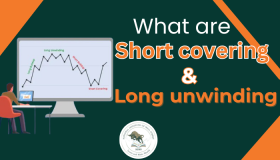15 Jan 2025
What Are Short Covering and Long Unwinding

In the dynamic world of trading, understanding market movements is key to making informed decisions. Two terms that frequently surface in this context are short covering and long unwinding. While they may sound technical, these concepts are straightforward and have a significant impact on market trends and price fluctuations.
This blog explores what short covering and long unwinding mean, why they occur, and how they influence the market. By the end, you’ll have a clear understanding of how to spot these movements and use them to your advantage.
What Is Short Covering?
Short covering happens when traders who have sold assets they don’t own (a process called short selling) buy them back to close their positions. This action is often triggered when prices rise unexpectedly, forcing these traders to cut their losses or when they choose to book profits after a significant price drop.
In simpler terms, short covering is like buying back what you’ve borrowed and sold earlier, usually at a higher price than expected.
Why Does Short Covering Happen?
-
Unexpected Price Rise:
Traders who short-sell expect the price to fall. When the opposite happens, and the price rises, they must buy back the asset to minimise losses. -
Profit Booking:
In some cases, traders who successfully shorted an asset during a price decline may choose to close their positions to lock in profits.
Impact of Short Covering on Prices
Short covering increases buying pressure in the market. Since traders are rushing to buy back the asset, demand increases, pushing prices higher. This often results in a sharp and sudden price rise, commonly referred to as a short squeeze when the rise is exaggerated.
Example of Short Covering
-
A trader believes a stock priced at ₹100 will drop to ₹80 and short-sells it at ₹100.
-
Instead of falling, the stock price rises to ₹110. To avoid further losses, the trader buys back the stock at ₹110, contributing to increased buying pressure and further price hikes.
What Is Long Unwinding?
Long unwinding refers to the process where traders or investors sell assets they already own (known as long positions) to exit the market. This usually occurs when they expect prices to fall or when they want to book profits after a significant price rise.
In simple terms, long unwinding is the act of selling your investments to either protect your gains or cut potential losses.
Why Does Long Unwinding Happen?
-
Fear of Price Decline:
-
Traders or investors sell their holdings when they anticipate a market downturn to avoid losses.
-
-
Profit Booking:
-
After a stock or asset has reached a desired profit level, investors may sell it to secure their earnings.
-
Impact of Long Unwinding on Prices
When traders unwind their long positions, they create selling pressure in the market. This increased selling activity often pushes prices downward, especially if large volumes are involved.
Example of Long Unwinding
-
A trader buys a stock at ₹100, expecting it to rise to ₹120.
-
Once the stock hits ₹120, the trader sells it to lock in profits.
-
This selling can lead to a dip in the stock’s price due to the increased supply in the market.
Difference Between Short Covering and Long Unwinding
While both short covering and long unwinding are critical trading concepts, they represent opposite actions in the market. Here’s a clear comparison to understand their differences:
|
Aspect |
Short Covering |
Long Unwinding |
|
Definition |
Buying back previously sold (shorted) assets. |
Selling assets already owned (long positions). |
|
Purpose |
To close short positions and minimise losses or book profits. |
To exit long positions due to price concerns or profit booking. |
|
Market Impact |
Increases buying pressure, driving prices up. |
Increases selling pressure, causing prices to drop. |
|
Trigger |
Rising prices force short sellers to buy back. |
Falling prices or profit targets encourage selling. |
|
Trader's Position |
Closing a bearish (negative) trade. |
Closing a bullish (positive) trade. |
|
Examples |
A trader short-sells at ₹100, price rises to ₹110, and they buy back. |
A trader buys at ₹100, price rises to ₹120, and they sell. |
Key Takeaways:
-
Short covering is about undoing a bet against the market by buying back assets.
-
Long unwinding is about selling assets you own to exit a position.
Understanding these differences can help traders anticipate price movements and adjust their strategies accordingly.
How to Spot Short Covering and Long Unwinding
Recognising short covering and long unwinding in the market can help traders make better decisions. Here’s how to identify each:
How to Spot Short Covering
-
Sharp Price Increase After a Decline:
-
Look for sudden spikes in price following a prolonged downtrend.
-
This indicates traders are buying back short-sold positions.
-
-
High Trading Volume:
-
During short covering, trading volume typically increases as short sellers rush to close their positions.
-
-
Short Interest Reports:
-
Monitor the short interest in a stock or asset.
-
If the short interest is high and the price starts rising, a short squeeze may occur, leading to short covering.
-
How to Spot Long Unwinding
-
Gradual Price Decline After a Rally:
-
Watch for steady price drops following a significant upward trend.
-
This is a sign that investors are booking profits or exiting positions.
-
-
Increased Selling Volume:
-
Long unwinding often leads to higher selling activity, causing a decline in price.
-
-
Market Sentiment Indicators:
-
Look for negative sentiment or bearish news that could trigger long position exits.
-
Using Technical Indicators
-
Volume Analysis: Sudden spikes in volume can hint at short covering or long unwinding.
-
Moving Averages: Prices breaking above resistance lines may indicate short covering, while dropping below support lines can signal long unwinding.
By closely analysing price movements, trading volumes, and market trends, you can spot these activities and adjust your strategy accordingly.
Why Are Short Covering and Long Unwinding Important for Traders?
Understanding short covering and long unwinding is crucial for traders as these activities significantly influence market trends and price movements. Here’s why they matter:
1. Predict Market Trends
-
Short Covering: Often causes a sharp rise in prices, signalling the start of an upward trend.
-
Long Unwinding: Indicates potential bearishness as prices begin to fall.
By recognising these patterns, traders can anticipate changes and position themselves accordingly.
2. Spot Trading Opportunities
-
Short Covering: Provides opportunities to capitalise on price surges during a short squeeze.
-
Long Unwinding: Allows traders to short-sell or exit before prices decline further.
3. Improve Timing for Trades
-
Spotting short covering helps traders enter bullish trades at the right moment, while recognising long unwinding helps avoid or prepare for price declines.
4. Minimise Risk
-
Knowing these concepts helps traders avoid being caught off guard by sudden market movements, such as unexpected price spikes or declines.
5. Understand Market Sentiment
-
Short covering often reflects panic among short sellers, while long unwinding indicates cautiousness among investors.
-
These activities provide insight into the market’s overall mood and expectations.
By paying close attention to these phenomena, traders can make smarter decisions and adapt quickly to market dynamics.
Conclusion
Short covering and long unwinding are critical concepts that every trader should understand. They provide valuable insights into market behaviour and help explain sudden price movements.
-
Short covering is when traders buy back assets they previously sold short, often driving prices upward.
-
Long unwinding, on the other hand, is when traders sell their owned assets, putting downward pressure on prices.
Both actions are influenced by market conditions, trader sentiment, and price trends. Recognising these patterns can help you predict price movements, improve trade timing, and reduce risk.
By combining this knowledge with technical analysis tools, you can gain a strategic edge in trading. Whether you’re looking to enter a bullish market during short covering or prepare for a bearish phase during long unwinding, understanding these concepts is key to making informed decisions.
Ready to Learn More?
Master the art of trading with expert guidance from NIWS Stock Market Institute in Jaipur. Learn advanced strategies, technical analysis, and market insights that can transform your trading journey.
